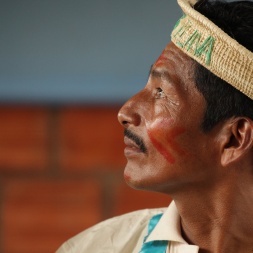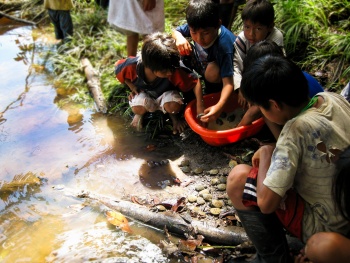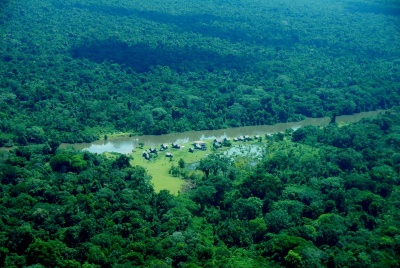An Interview with Romero Ríos, President of the Indigenous Maijuna Federation
06/18/2015
Below is an interview with Romero Ríos, President of the Maijuna Indigenous Federation, on the national declaration of the Maijuna-Kichwa Regional Conservation Area (RCA) on June 17, 2015. This vast reserve protects 977,600 acres of richly biodiverse Amazon rainforest in Peru’s western Loreto region, as well as the ancestral homeland of the indigenous Maijuna people.
How long have the Maijuna worked with NCI for, and how has NCI supported their efforts to create this reserve?
We have been working with NCI since 2008. NCI provide us with workshops and training on capacity building for our leaders. In our communities, NCI has provided technical support in different ways, including helping us to develop several projects such as fisheries management, turtle breeding projects, handcrafts projects and aguaje palm management. NCI has also provided us with legal support like ensuring the recognition of our villages in the national records, which is important to legally identifying ourselves as Maijuna people. NCI has also helped us implement our internal agreements or community regulations for carrying out sustainable development projects.
It has been eight years of close work between the Maijunas and NCI, and I believe that this work has paid off. That is why we can’t detach from each other, because we have a common interest, both NCI and the Maijuna and Kichwa Federations, we are working together toward sustainable development.
What activities are the Maijuna people developing in their communities with NCI’s support?
Together we have worked on activities for the sustainable management of the forest and the aguaje palm swamps. We are managing several aguajales areas, monitoring and understanding the productivity of these palms, mapping the extension of aguajales that we have, and recognizing the young species that require more care from us. With NCI, we have also worked on a turtle breeding project and in the use of chambira palm fibers. For this project we planted seedlings of chambira palms that are growing fast, they are big already! With the chambira fibers we produce baskets and other crafts thanks to the training provided by NCI. Once NCI brought expert artisans from the Tamshiyacu Tahuayo Reserve and the Alto Nanay Reserve who guided the artisan mothers, girls and boys of our villages on this art. Also, our artisans received three specialized trainings that focused on improving the quality of their artwork.
What does the government’s official support of this reserve mean for you and your people?
With the recognition of the Maijuna-Kichwa reserve by the national government we feel that the doors have been opened. Before we were saying that we had to look through a little window as we could not make any progress toward our goals. Now with this open door, we feel we can propose future projects for the development of the Maijuna and Kichwa people to improve the livelihood our populations, not only to benefit our own people but also for the benefit of the entire Loreto region.
Why do you believe it is so important to conserve these natural areas now and for future generations?
We have seven headwater basins within the reserve, and wildlife zones that serve as a refuge for the many animals that live in this environment. These forest resources are our market source, as we have medicinal plants and trees. These resources will sustain us. In the future, the children that are born in our areas will have a secure market source, and secure medicines to use throughout their lives. These kids are going to stay in the villages and finally when they grow up they are going to say “This is my land and I can use these resources because I have a secure market source now.” This way, our youth are not going to be displaced or forced to leave the forest. Securing these areas for the future of our people is our job as the heads of the Maijuna and Kichwa indigenous federations.
How will the protection of these areas enhance your livelihood and local economy?
We always strive for development through sustainable projects that generate income for us without disturbing the forest. We envision our future development through projects that improve the quality life for our children without depleting the forest. For example, because of the vast size of the reserve, we could think about doing carbon sequestration projects in the future. However, in minor scale, we also need to think of projects such as electricity that could permit us to form projects of larger scale with improved technology and communication.
How will the protection of these areas preserve your culture?
I think that conservation brought us closer to each other. When we started this project, the Maijuna’s processes and aspirations were dispersed, but that has changed, we are now united and we feel this is the way that our culture is going to flourish and grow again. When we started the project, only ten children were able to speak the Maijuna language. Today, we have achieved almost forty or fifty, therefore our activities for cultural development need to be maintained and constantly improved. We will aim for this with the support of the bilingual teachers in our communities as well as the parents that are participating in the cultural workshops.
How is the national declaration going to change the lives of future generations?
We want to continuously make changes toward progress. Those years when we started the project we were younger and had no security. But now that we feel secure, we want to continue seeking for more projects for our youth, so they can benefit from the area in many ways. Our Regional Conservation Area hosts such an enormous quantity of natural resources in the environment which means that our young people are going to have a secure source for feeding themselves. It is our duty to oversee the reserve so that it will facilitate economic growth. In the past we had no source of income from the forest, but now we will have enough not only feed our families but also to benefit the regional market, for example the city of Iquitos.
Some people might think that this is a huge area for a few number of Maijuna and Kichwas, around 4,500 inhabitants, what do you think?
I believe that this area of 977,600 acres is not only for the Maijunas, it is for everyone who directly needs the resources from these zones and also for supplying the region, because if outsiders need support, now we can say to them “Here, this is the conservation area, we have resources that we can share.” The Regional Government of Loreto, which is the promoter entity of our conservation area, is part of this management, so both parties, the indigenous and the government, are supervising the use of the area. With an appropriate regulation, for example, outsiders can have a limited quota to use the resources and this is how the Regional Conservation Area is going to serve to the entire regional population of Loreto.
Can you give us a brief message in your native language?
[Message in Maijuna language]
Can you translate for us?
I said that I am grateful for this National Decree that has the signature of the President Humala, and now I am going back to tell the news to my Maijuna communities in Puerto Huaman, Nueva Vida, Sucusari, Totolla and to the Kichwa people, I am going to tell all of them that we got it. We thank President Humala.






